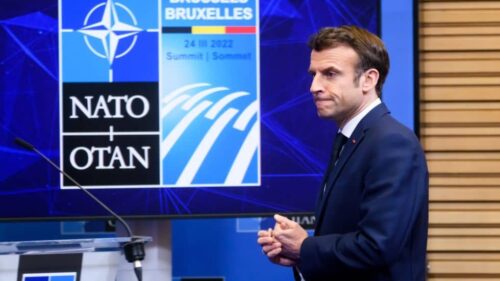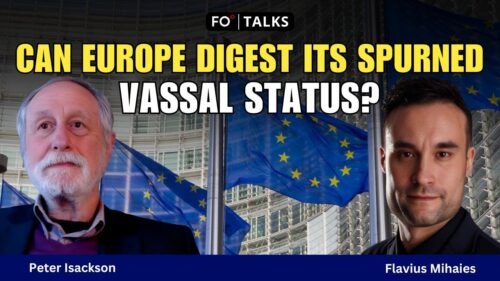Lord Hastings Ismay, before he took up office as NATO’s first Secretary General, said that the purpose of the alliance was, “to keep the Soviet Union out, the Americans in, and the Germans down.” These words, spoken in the immediate aftermath of World War II, reflected the distrust of Germany after two terribly destructive wars within 30 years, the belief that the Soviet Union posed a threat to post-war Europe and the appreciation that Europe was in no position to defend itself without US support.
The fear of a resurgent Germany has long since fallen away, but the war in Ukraine has brought into stark relief the perception of a renewed threat to Europe from Russia. This, coupled with the US strategic focus turning towards China and the Indo-Pacific region, accentuated by the America First policy of the Trump administration, raises three interlinked questions for Europe. How do the Europeans ensure that they can keep Russia out? How do they keep the US engaged, at least in the mid-term? What architecture best suits European defense in the future, with or without the US?
Keeping the Russians out — political will
Keeping the Russians out requires credible European defense, which relies on both political will and military capability. If we take it as given that the principal aim of defense policy for Europe is to deter aggression, then the Russian perception of the strength of political will on the part of NATO and the EU is critical. At the institutional level, the political support of the EU and NATO for Ukraine has been unwavering, but this papers over very divergent positions taken by member states.
The various contributions in military aid are revealing. As of June 30, 2025, the US was the most important contributor of military aid at €64.62 billion ($75.60 billion). However, aid from NATO members and other European states has exceeded that of the US, contrary to what one may believe from statements by US President Donald Trump, totaling €79.14 billion ($92.58 billion). Germany (€16.51 billion [$19.31 billion]), the UK (€13.77 billion [$16.11 billion]) and, perhaps surprisingly, Denmark (€9.16 billion [$10.72 billion]) were the three most important suppliers after the US, with France (€5.96 billion [$6.97 billion]) sixth of European contributors.
Indicative of the different perspectives within the European allies, Hungary has not contributed any military aid. If we look at financial, humanitarian and military aid in total, the principal contributors remain the same in a similar ranking, with the exception that the EU institutions come into the picture with €63.2 billion ($73.93 billion) of financial and humanitarian aid. Hungary has contributed only a very modest €0.05 billion ($0.06 billion) of humanitarian aid.
Another political aspect has been the unexpected adherence of both Sweden and Finland to NATO — unthinkable before the Russian invasion in 2022. A complex and contradictory picture confronts the Russians: some strong signals but some weaknesses to exploit. Whether these weaknesses would be there if there were a direct threat to a NATO member is, of course, an imponderable.
Equally, despite the ambiguities surrounding the Trump administration’s support for Ukraine and its desire to avoid foreign entanglements, it would be dangerous for the Russians to assume that the US would not come to the aid of a NATO ally in the event of direct aggression.
Keeping the Russians out — military capabilities
Assuming that there is the political will to keep the Russians at bay, how does military capability within Europe shape up? The picture is mixed. The two most capable armed forces, in terms of quality and breadth of capabilities, are those of the UK and France.
However, over recent years, both nations have focused much of their effort on low-intensity counter terrorist operations and global reach at the expense of preparing for a major European conflict. It seems that the lesson of Ukraine has been learnt, but it will take time to switch emphasis.
On the positive side, there is an independent nuclear capacity held by France and the UK. On the conventional, non-nuclear level, there is a patchwork of capabilities, readiness and combat experience within European armed forces. In this context, after many years of neglect, the recent renewed commitment by Germany to defense is very important.
Perhaps the most significant problem for the non-US NATO members is that they rely heavily on the US for target acquisition and reconnaissance, suppression and destruction of enemy air defenses, command and control functions, electronic warfare and resupply of munitions and other consumables in any major conflict.
In this context, a major European war cannot be viewed in isolation. If the US were to be involved in a major operation elsewhere, such as a Chinese blockade or invasion of Taiwan, these capabilities for use in Europe and resupply of munitions would likely be compromised. Non-US NATO nations must prioritize acquiring these capabilities where they are lacking and enhancing them where they are present but at insufficient levels.
They must also improve the capacity of the European armaments industries for the manufacture of equipment and replenishment of consumables. However, there are supply chain issues outside of Europe that also need to be addressed. As an example, Europe relies on China for more than 70% of its requirements for cotton linters, used to manufacture nitrocellulose for artillery shells and other explosives.
Another dimension to keeping the Russians out is “where would the blow fall?” The least likely scenario is a direct thrust through Poland, but it is probably the threat for which NATO is best prepared. Perhaps the most likely threat is against the Baltic states, all of which have a common land border with either Belarus or Russia.
The challenge for NATO is that the only route for overland access to the Baltic states is the short, roughly 50-mile-long border between Poland and Lithuania, sandwiched between the Russian Kaliningrad enclave and Belarus. All other deployment or resupply would need to come by sea or air, requiring control of both over and in the Baltic Sea. Fortunately, air and maritime power are strong European capabilities.
Keeping the Americans in
President Trump has long been critical of NATO, particularly his perception that the US bears a disproportionate burden for European defense, and he has threatened to withhold support if nations do not pull their weight. On June 24, 2025, en route to the NATO summit in the Netherlands, he commented on Article 5 of the North Atlantic Treaty to journalists, “Depends on your definition. There are numerous definitions of Article 5. You know that, right? But I’m committed to being their friends.”
It is worth a look at the wording of Article 5: “The Parties agree that an armed attack against one or more of them in Europe or North America shall be considered an attack against them all and consequently they agree that, if such an armed attack occurs, each of them … will assist the Party or Parties so attacked by taking forthwith … such action as it deems necessary, including the use of armed force …” The military commitment of the US has long been taken for granted, and the widely held view has been that Article 5 implies the commitment of military force.
In essence, President Trump is correct, but his statement raises the specter of US support short of military engagement, perhaps limited to diplomatic or logistic support. Currently, the greatest guarantee of US military engagement is the deployment of 84,000 US armed forces personnel in Europe, spread widely but with the greatest deployments in the UK, Germany, Italy and Poland. This is a significant contribution, but well below the troop ceiling of 326,414 set by Congress in 1985 during the Cold War.
Non-US NATO forces have more than 3,000,000 active personnel, but the importance of the US contribution is not simply the numbers stationed in Europe but also the quality of the capabilities deployed and the overall strength of US forces worldwide. There is speculation that the US is reviewing its force levels in Europe with an announcement due in the fall of 2025. If this were to result in a drawdown, then the concern for Europe must be at what number do US force levels in Europe fall below a critical mass, which may lead Russia to conclude that US engagement has been fatally weakened.
The best means for the NATO European nations to convince the US that it is serious about its own defense, and hence keep the US engaged, is by increasing their defense spending. On June 25, 2025, a NATO summit agreed that members “would commit to investing 5% of GDP in defense – including 3.5% of GDP on core defense requirements and 1.5% on defense and security-related investments like infrastructure and industry. This marks a major uplift from the previous benchmark of 2% of GDP.”
It remains to be seen how this translates into defense budgets. In February 2025, the UK announced an increase in UK defense spending from 2.3% GDP to 2.5% by April 2027, with an “ambition” of reaching 3% within the next parliament (in effect by 2034), short of the 3.5% target. France’s President Macron has pledged to increase the country’s defense budget from a little over 2.0% in 2024 to 3.5% by 2030.
However, both the UK and France face serious overall budget challenges, with the added dimension of an unstable political situation in France and a presidential election due in 2027. Germany has increased its defense budget for 2025 to 2.4% and plans to reach the 3.5% NATO target by 2029.
The other nations’ budgets for 2024 ranged from around 1.5% for Spain to more than 4% for Poland. How all this will pan out, particularly with the scope for creative accounting with the formula for 1.5% for “defense and security-related” expenditure, is anybody’s guess. An unanswerable question is, will the foot come off the accelerator if a peace accord is found in Ukraine?
In the short term, the NATO agreement on defense budgets seems to have satisfied President Trump, but it would be unwise to assume that the US will remain engaged in the long term. What future defense architecture best suits Europe in the future, with or without the US? First of all, how did we get where we are now?
The evolution of post-war defense in Europe
How Europe should best defend itself has been on the political agenda since shortly after the end of World War II, periodically coming to the fore and then slipping into the background as the perception of the threat has varied.
In 1947, France and the UK signed the Dunkirk mutual assistance pact — not to counter any perceived Soviet threat but to forestall, however unlikely that may seem now, any resurgent threat from Germany. Within a year, the growing threat from the Soviet Union resulted in the expansion of the Dunkirk pact into the Western Union (WU), incorporating Belgium, the Netherlands and Luxembourg.
The WU, established by the Brussels Treaty in March 1948, provided for military, economic, social and cultural cooperation. However, a succession of other institutions (the Organization for European Economic Cooperation [April 1948], NATO [April 1949], the Council of Europe [May 1949] and the European Coal and Steel Community [April 1951]) effectively stripped the WU of many of its functions.
The creation of NATO, which brought together nine European nations, Iceland, Canada and the US in a treaty for collective defense, was the most significant post-war development. Faced with the outbreak of the Korean War in 1950, the maintenance of large Soviet forces in Eastern Europe, and with the French and the British heavily committed in Indochina and Malaya respectively, NATO members recognized that the forces available in Europe were inadequate to counter Soviet forces.
There was growing pressure, particularly from the US, to allow Western Germany (the Federal Republic of Germany, [FRG]) to rearm and contribute to European defense, but there was opposition from France and Belgium to the reestablishment of independent German armed forces.
The French formulated a counterproposal in 1950 for the creation of a European Defense Community (EDC) and a European army, which would include German forces integrated in a supranational structure, sidestepping the issue of independent German forces. This culminated in the Treaty of Paris signed by France, Belgium, the Netherlands, Luxembourg, Italy and the FRG at the end of May 1952.
This ambitious project envisaged an integrated army of 40 divisions assigned to NATO supreme command with a common budget, common arms and centralized procurement. The project eventually floundered when France got cold feet over the loss of sovereignty and suspended treaty ratification in August 1954. Italy had been waiting to see which way France would jump, and it also suspended ratification. As an aside, in April 2025, an Italian member of parliament introduced a bill to reconsider ratification. However, it is most unlikely that a resurrected EDC will be the instrument for enhancing European defense in the future.
In the wake of the collapse of the EDC, events moved quickly. In October 1954, the WU transitioned into the Western European Union (WEU). Italy and the FRG joined the five members of the WU, the allied occupation of the FRG was ended and the FRG was authorized to rearm.
In May 1955, the FRG joined NATO. In response, the Soviet Union created the Warsaw Pact (WP) for the Soviet satellite states in Eastern Europe. Greece and Turkey had also joined NATO in 1952, and Spain joined in 1982, ending the Cold War expansion of NATO. A further development in European defense integration during this period was the creation of a joint Franco-German Brigade, around 6,000 strong, in 1989.
Following the collapse of the Soviet Union and the dissolution of the WP in 1991, there was an expansion of both the EU and NATO, and in 1992, France and the newly reunified Germany founded the Eurocorps. The Eurocorps has steadily expanded with the addition of Belgium, Spain, Luxembourg and Poland as framework nations with Austria, Greece, Italy, Romania and Turkey as associate nations.
However, Eurocorps has no standing forces; it is a corps headquarters that can take under command European Battle Groups. The corps is assigned to both NATO and the EU. The WEU had been largely dormant during the Cold War; there were periodic attempts to revive it until it was finally dissolved in 2011, with its functions absorbed into the EU under the auspices of the European Security and Defense Identity.
The future of European defense
There has been much talk over the years, often driven by the French, of the need for enhanced European defense and indeed a European army. A major stumbling block has been the opposition, by the US and the UK in particular, to the creation of parallel structures to those of NATO, seen as wasteful and divisive, and also a potential risk to continuing US commitment to the defense of the European continent.
A recent paper published by the Washington-based Center for Strategic and International Studies raises the issue again of a European army, proposing a supranational common EU force, an EU unified command headquarters integrated into the NATO command structure, development of integrated forces for such tasks as air-to-air refueling, air transport, intelligence and targeting, command and control, and an EU defense intelligence service. Overall control would be vested in the EU Council of Ministers.
The long-standing concerns over duplication of effort remain, and there are practical issues with many of the proposals. More importantly, there is a fundamental problem with all proposals for supranational armed forces — the elephant in the room, which effectively left the EDC still borne, the issue of national sovereignty. Within NATO, all nations delegate operational command but retain full command of their armed forces.
In other words, they keep the ultimate power concerning their commitment or not. No NATO or other multinational force commander will have full command over other national forces. This simply reflects the reality that nations will not cede sovereignty of their armed forces. This, in turn, is because armed forces are an instrument of foreign policy; foreign policy leads defense policy, and not the inverse. To paraphrase Karl von Clausewitz in On War, “War is the continuation of politics by other means.”
Although the EU has a foreign minister, or more correctly a High Representative of the Union for Foreign Affairs and Security Policy, foreign policy is not supranational and is subject to decisions of the Council of Ministers. A general, all-embracing supranational foreign policy is difficult to envisage short of the creation of a federal European state — for example, France has worldwide interests with its overseas territories and legacy involvement in Africa, while its EU partners have diverse and narrower foreign policy interests.
Nevertheless, interest in a European army has ebbed and flowed with the perceived threat. When the Soviet threat disappeared and Russia seemed a potential partner, then one could abstractly talk of a European army.
France has been, and remains, a strong proponent of enhanced European defense, but it is not always clear what this means. Does this mean it should be centered on the EU or a broader view of Europe? EU-based defense has attractions for those committed to the evolution of the European project, but it has inherent problems — setting aside the US, it excludes three European NATO members, Norway, the UK and Turkey, and two peripheral members, Canada and Iceland. Excluding the UK would be foolhardy, and its integration in an EU structure impracticable post-Brexit.
Iceland, although it does not have armed forces, would be strategically important in the event of a major European war with its air base at Keflavik, vital for maritime air anti-submarine operations to counter Russian submarines penetrating the Greenland-Iceland-UK Gap to threaten trans-Atlantic maritime lines of communication.
Similarly, Norway and Turkey are in critical strategic positions on the European flanks — the latter controlling the Bosphorus and access to the Black Sea. Also, the presence of Austria, Malta and Ireland as neutral states within the EU does not sit easily with the development of an EU-wide military alliance.
With the appreciation that a resurgent Russia poses a threat to Europe, reality has returned and NATO is once again, at least implicitly, seen as the vehicle for enhancing European defense. Nevertheless, the French position remains ambivalent. President Macron, in an interview with The Economist in 2019, said that “What we are currently experiencing is the brain death of NATO,” with it having “lost its strategic focus.”
In March 2022 he said that “The war launched by President Putin brings a clarification, and creates at our borders and on our European soil an unusual threat which gives a strategic clarification to NATO … Yet, I continue to think that we need to rebuild a new European order of security, that the war today in Ukraine makes it even more indispensable.” By March 2025 this had evolved to a statement that France was a “loyal and faithful” NATO ally.
It is possible that Macron would still prefer an alliance based on the EU, but to move in this direction would not only create expensive and unnecessary duplication but also fail to make use of many years of experience with NATO: command structures, joint operating procedures, standardisation, co-ordinated long-term defense planning, interoperability and command and control.
US predominance in command positions need not stand in the way of a greater European role in NATO, or indeed a NATO minus the US. If the US were to withdraw from NATO or not participate in a given operation in response to a crisis, the NATO command structure is sufficiently flexible to operate without US commanders — those commanders who are American all have non-US deputies and/or chiefs of staff.
Providing credible European defense with reduced reliance on the US requires commitment of adequate resources by European nations, and their development and enhancement of those capabilities which are currently exclusively or predominantly provided by the US. European defense, in the broad sense, can best be served by the existing NATO framework.
[Casey Herrmann edited this piece]
The views expressed in this article are the author’s own and do not necessarily reflect Fair Observer’s editorial policy.
Support Fair Observer
We rely on your support for our independence, diversity and quality.
For more than 10 years, Fair Observer has been free, fair and independent. No billionaire owns us, no advertisers control us. We are a reader-supported nonprofit. Unlike many other publications, we keep our content free for readers regardless of where they live or whether they can afford to pay. We have no paywalls and no ads.
In the post-truth era of fake news, echo chambers and filter bubbles, we publish a plurality of perspectives from around the world. Anyone can publish with us, but everyone goes through a rigorous editorial process. So, you get fact-checked, well-reasoned content instead of noise.
We publish 3,000+ voices from 90+ countries. We also conduct education and training programs
on subjects ranging from digital media and journalism to writing and critical thinking. This
doesn’t come cheap. Servers, editors, trainers and web developers cost
money.
Please consider supporting us on a regular basis as a recurring donor or a
sustaining member.
Will you support FO’s journalism?
We rely on your support for our independence, diversity and quality.













Comment